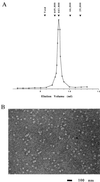Small heat shock protein of Methanococcus jannaschii, a hyperthermophile
- PMID: 9689045
- PMCID: PMC21303
- DOI: 10.1073/pnas.95.16.9129
Small heat shock protein of Methanococcus jannaschii, a hyperthermophile
Abstract
Small heat shock proteins (sHSPs) belong to a family of 12- to 43-kDa proteins that are ubiquitous and are conserved in amino acid sequence among all organisms. A sHSP homologue of Methanococcus jannaschii, a hyperthermophilic Archaeon, forms a homogeneous multimer comprised of 24 monomers with a molecular mass of 400 kDa in contrast to other sHSPs that show heterogeneous oligomeric complexes. Electron microscopy analysis revealed a spherically shaped oligomeric structure approximately 15-20 nm in diameter. The protein confers thermal protection of other proteins in vitro as found in other sHSPs. Escherichia coli cell extracts containing the protein were protected from heat-denatured precipitation when heated up to 100 degreesC, whereas extracts from cells not expressing the protein were heat-sensitive at 60 degreesC. Similar results were obtained when purified sHSP protein was added to an E. coli cell lysate. The protein also prevented the aggregation of two purified proteins: single-chain monellin (SCM) at 80 degreesC and citrate synthase at 40 degreesC.
Figures





Similar articles
-
On the mechanism of chaperone activity of the small heat-shock protein of Methanococcus jannaschii.Proc Natl Acad Sci U S A. 2003 Jul 8;100(14):8151-5. doi: 10.1073/pnas.1032940100. Epub 2003 Jun 19. Proc Natl Acad Sci U S A. 2003. PMID: 12817080 Free PMC article.
-
Molecular chaperone activity of tomato (Lycopersicon esculentum) endoplasmic reticulum-located small heat shock protein.J Plant Res. 2008 Mar;121(2):235-43. doi: 10.1007/s10265-008-0148-x. Epub 2008 Feb 21. J Plant Res. 2008. PMID: 18288562
-
A small heat shock protein stably binds heat-denatured model substrates and can maintain a substrate in a folding-competent state.EMBO J. 1997 Feb 3;16(3):659-71. doi: 10.1093/emboj/16.3.659. EMBO J. 1997. PMID: 9034347 Free PMC article.
-
Functional identification of the SecB homologue in Methanococcus jannaschii and direct interaction of SecB with trigger factor.Biochem Biophys Res Commun. 2004 Mar 19;315(4):1039-44. doi: 10.1016/j.bbrc.2004.02.002. Biochem Biophys Res Commun. 2004. PMID: 14985117
-
Small heat shock proteins from extremophiles: a review.Extremophiles. 2004 Feb;8(1):1-11. doi: 10.1007/s00792-003-0362-3. Epub 2003 Nov 19. Extremophiles. 2004. PMID: 15064984 Review.
Cited by
-
Microbial ecology of the dark ocean above, at, and below the seafloor.Microbiol Mol Biol Rev. 2011 Jun;75(2):361-422. doi: 10.1128/MMBR.00039-10. Microbiol Mol Biol Rev. 2011. PMID: 21646433 Free PMC article. Review.
-
Artemin as an efficient molecular chaperone.Protein J. 2011 Dec;30(8):549-57. doi: 10.1007/s10930-011-9359-4. Protein J. 2011. PMID: 21979748
-
The plant sHSP superfamily: five new members in Arabidopsis thaliana with unexpected properties.Cell Stress Chaperones. 2008 Summer;13(2):183-97. doi: 10.1007/s12192-008-0032-6. Epub 2008 Mar 28. Cell Stress Chaperones. 2008. PMID: 18369739 Free PMC article.
-
A virus-like particle vaccine platform elicits heightened and hastened local lung mucosal antibody production after a single dose.Vaccine. 2012 May 21;30(24):3653-65. doi: 10.1016/j.vaccine.2012.03.035. Epub 2012 Mar 28. Vaccine. 2012. PMID: 22465748 Free PMC article.
-
Regulation and mechanism of action of the small heat shock protein from the hyperthermophilic archaeon Pyrococcus furiosus.J Bacteriol. 2001 Sep;183(17):5198-202. doi: 10.1128/JB.183.17.5198-5202.2001. J Bacteriol. 2001. PMID: 11489874 Free PMC article.
References
-
- Gething M J, Sambrook J. Nature (London) 1992;355:33–45. - PubMed
-
- Hendrick J P, Hartl F-U. Annu Rev Biochem. 1993;62:349–384. - PubMed
-
- Parsell D A, Lindquist S. In: The Biology of Heat Shock Proteins and Molecular Chaperones. Morimoto R I, Tissieres A, Georgopoulos C, editors. Cold Spring Harbor, NY: Cold Spring Harbor Lab. Press; 1994. pp. 457–494.
-
- Buchner J. FASEB J. 1996;10:10–19. - PubMed
-
- Caspers G-J, Leunissen J A M, de Jong W W. J Mol Evol. 1995;40:238–248. - PubMed
Publication types
MeSH terms
Substances
LinkOut - more resources
Full Text Sources
Other Literature Sources

